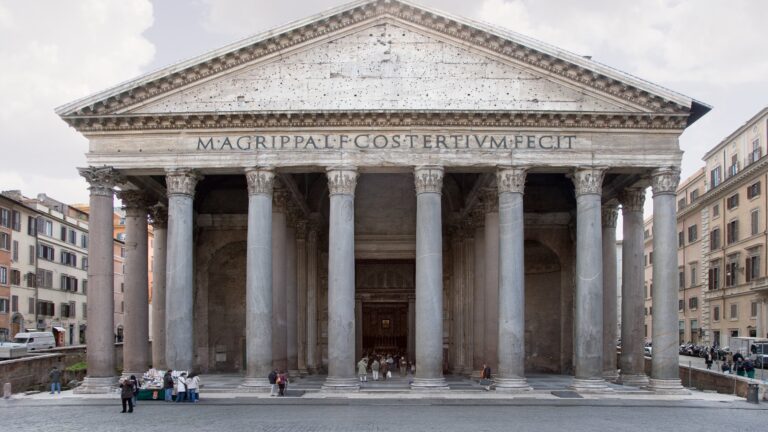The Pantheon is one of the best preserved monuments of ancient Rome. The structure, completed around 126-128 AD during the reign of Emperor Hadrian, features a rotunda with a massive domed ceiling that was the largest of its kind at the time of its construction. The Pantheon is located on the site of an earlier structure of the same name, built around 25 BC by the statesman Marcus Agrippa, and is believed to have been designed as a temple to the Roman gods.
Due to the lack of written records, many unknowns surround the current Pantheon, including who designed it and how long its construction took.
The design of the Pantheon has influenced countless buildings throughout history, in Europe and the Americas. Today, the Pantheon continues to function as a church and as a major tourist destination.
Origins
The current Pantheon is located on the site of an earlier structure of the same name, built around 25 BC by the statesman Marcus Agrippa, son-in-law of the first Roman emperor, August.
Traditionally believed to have been designed as a temple for the Roman gods, the structure’s name is derived from the Greek words stove, meaning “all”, and theos, meaning “gods”.
The original Pantheon was destroyed in a fire around 80 AD. It was rebuilt by Emperor Domitian, only to be burned down again in 110 AD.
8 Incredible Roman Technologies
Hadrian became emperor in 117, at a time when the Roman Empire included much of present-day Europe, as well as parts of the Middle East and North Africa. Passionate about art and architecture, he launched a construction campaign under his reign which lasted until his death in 138.
Among these construction projects was a defensive fortification, today called Hadrian’s Wall, marking the northwest border of the Roman Empire. The wall is 73 miles long and stretches from coast to coast across modern-day northern England.
It is not known who the architect of the existing Pantheon was or what exact role Hadrian played in the project. Evidence suggests that the Pantheon was consecrated around AD 126-128, although construction may have begun under Hadrian’s predecessor Trajan, who was emperor from 98 to 117.
It’s not clear why, but Hadrian placed Agrippa’s original inscription on the new Pantheon – “Marcus Agrippa, son of Lucius, thrice consul, did this” – which led to centuries of confusion over his origins.
No one knows the original purpose of the current Pantheon, but Hadrian sometimes held his court there.
From the pagan temple to the Christian Church
In 330, the capital of the Roman Empire was transferred from Rome to Byzantium (present-day Istanbul, Turkey) by the emperor. Constantine.
Subsequently, the Pantheon fell into a long period of disrepair. In 476, the German warrior Odoacer conquered the western half of the Roman Empire, where Rome was located.
The long decline of the Pantheon continues. Then, in 609, Pope Boniface IV obtained permission from the Byzantine emperor Phocas to convert the Pantheon into a Christian church, known in Latin as Sancta Maria ad Martyres (Saint Mary and the Martyrs).
It was the first pagan Roman temple to be dedicated as a Christian church. The conversion played a key role in the survival of the Pantheon, as the papacy had the resources to repair and maintain it.
Dome of the Pantheon
Made primarily of brick and concrete, the Pantheon consists of three sections: a portico with granite columns, a massive domed rotunda, and a rectangular area connecting the other two sections.
Measuring 142 feet in diameter, the domed ceiling was the largest of its kind when it was built. At the top of the dome is an opening, or oculus, 27 feet wide. The oculus, which has no covering, lets light, as well as rain and other bad weather, into the Pantheon.
The walls and floor of the rotunda are decorated with marble and gilding and the domed ceiling contains five rings of 28 rectangular chests.
When the artist Michelangelo Having seen the Pantheon centuries after its construction, he is said to have declared that it was the work of angels and not of man. The Pantheon proved an important influence for the great Renaissance architect Andrea Palladio, as well as countless architects who followed, in Europe and beyond.
Thomas Jefferson modeled both Monticello-his home near Charlottesville, Virginia- as well as the Rotunda building in University of Virginia, after the Pantheon. The rotunda of the United States Capitol was inspired by the Pantheon, as were several American state capitals.
The Pantheon today
After the Pantheon was converted into a Christian church, it eventually became the burial place of Renaissance figures, including the painter Raphaelthe composer Arcangelo Corelli and the architect Baldassare Peruzzi.
Several monarchs are also buried there, including Vittorio Emanuele II, who died in 1878 and was the first king of Italy since the 6th century; his son, Umberto I, assassinated in 1900, and Umberto’s wife, Queen Margherita, died in 1926.
Today, the Pantheon is a major tourist destination for visitors from around the world, while continuing to function as a church. Catholic masses are regularly celebrated there.
Sources
Hadrian: life and legacy. The British Museum
Interior of the Pantheon, Rome (painting). National Art Gallery.
The pantheon William L. MacDonald. Harvard University Press


